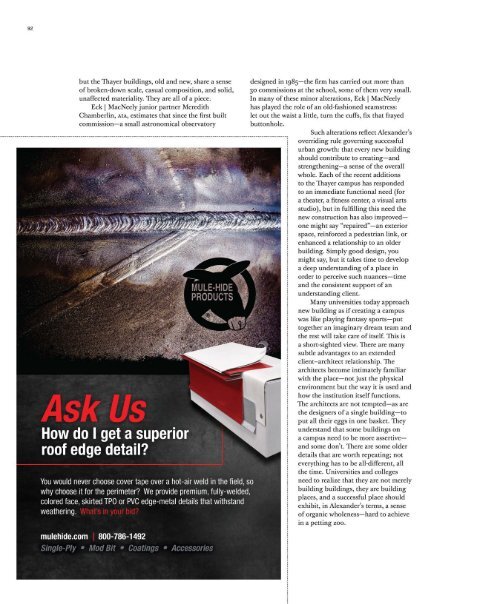Architect 2016-01
You also want an ePaper? Increase the reach of your titles
YUMPU automatically turns print PDFs into web optimized ePapers that Google loves.
92<br />
but the Thayer buildings, old and new, share a sense<br />
of broken-down scale, casual composition, and solid,<br />
unaffected materiality. They are all of a piece.<br />
Eck I MacNeely junior partner Meredith<br />
Chamberlin, AIA, estimates that since the first built<br />
commission-a small astronomical observatory<br />
designed in 1985-the firm has carried out more than<br />
30 commissions at the school, some of them very small.<br />
In many of these minor alterations, Eck I MacNeely<br />
has played the role of an old-fashioned seamstress:<br />
let out the waist a little, turn the cuffs, fix that frayed<br />
buttonhole.<br />
Such alterations reflect Alexander's<br />
overriding rule governing successful<br />
urban growth: that every new building<br />
should contribute to creating-and<br />
strengthening-a sense of the overall<br />
whole. Each of the recent additions<br />
to the Thayer campus has responded<br />
to an immediate functional need (for<br />
a theater, a fitness center, a visual arts<br />
studio), but in fulfilling this need the<br />
new construction has also improvedone<br />
might say "repaired"-an exterior<br />
space, reinforced a pedestrian link, or<br />
enhanced a relationship to an older<br />
building. Simply good design, you<br />
might say, but it takes time to develop<br />
a deep understanding of a place in<br />
order to perceive such nuances-time<br />
and the consistent support of an<br />
understanding client.<br />
Many universities today approach<br />
new building as if creating a campus<br />
was like playing fantasy sports-put<br />
together an imaginary dream team and<br />
the rest will take care of itself. This is<br />
a short-sighted view. There are many<br />
subtle advantages to an extended<br />
client-architect relationship. The<br />
architects become intimately familiar<br />
with the place-not just the physical<br />
environment but the way it is used and<br />
how the institution itself functions.<br />
The architects are not tempted-as are<br />
the designers of a single building-to<br />
put all their eggs in one basket. They<br />
understand that some buildings on<br />
a campus need to be more assertiveand<br />
some don't. There are some older<br />
details that are worth repeating; not<br />
everything has to be all-different, all<br />
the time. Universities and colleges<br />
need to realize that they are not merely<br />
building buildings, they are building<br />
places, and a successful place should<br />
exhibit, in Alexander's terms, a sense<br />
of organic wholeness-hard to achieve<br />
in a petting zoo.

















